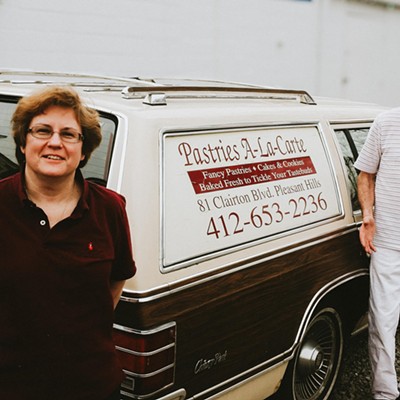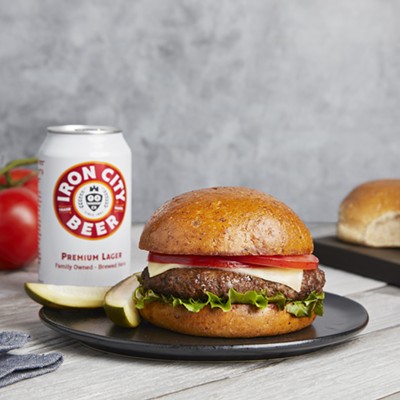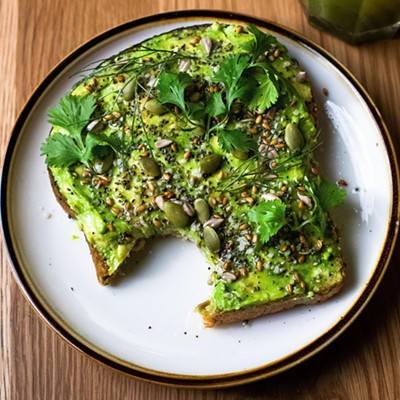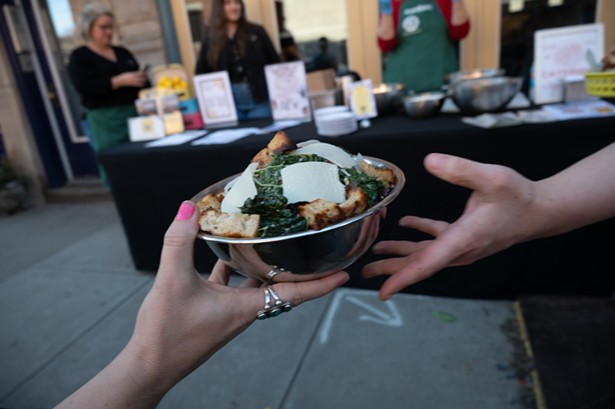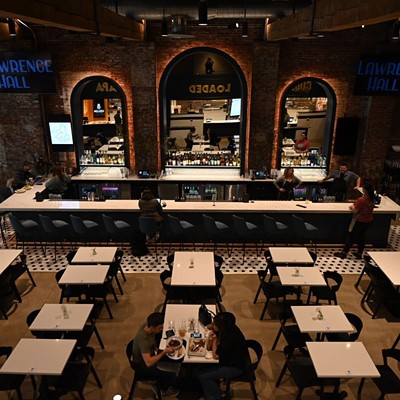LA FERIA
On the second floor above Pamela's on Walnut Street is La Feria, Pittsburgh's only Peruvian art-and-craft gallery and café. With only a couple dozen seats tucked into the back of the gallery, it's cozy, cheerfully decorated with wares, and despite the lack of street-level signs, it's one of Walnut Street's worst-kept secrets.
My companion began with the evening's soup -- black bean. The soup was rich and creamy, and packed with whole beans, rice, slivers of carrot and bacon. Very hearty and flavorful, it could have been a meal in itself. I started with an empanada, which is a small pastry turnover filled with vegetables, cheese, meat or combination thereof, and served with an onion salsa. That night, chicken or spinach-and-cheese were on offer. I chose chicken, but was pleasantly surprised to find tasty bonus morsels -- an olive and a red grape -- tucked into the empanada.
I could come here just to eat the camotes fritos, thin sweet-potato chips -- crisp but never greasy -- and the Huancaina dip that accompanies them. The dip -- named for the Peruvian mountain city of Huancayo -- is creamy and sweet, a little cheesy but with the slight bite of garlic and aji pepper. It turned out that the sweet-potato chips also made an excellent topping for the bean soup.
For a meal, there's a few sandwiches -- the spicy shredded beef, ropa vieja ("old clothes") on French bread always sounds tasty or larger-sized salads. But, it's too hard to resist the daily specials, which are usually slow-cooked meat or vegetarian dishes served with a side of garlic rice, salad and French bread. The specials are most likely to incorporate unusual ingredients and spices. If you can't choose between the specials, for an extra dollar you can get a combination plate with helpings of both.
On offer that night was a chicken dish, as well as two vegetarian selections: causa de pallares -- butter beans cooked with tomatoes, cheese and hot peppers -- and mote chorreado, a Peruvian corn special.
I had the arroz con pollo, chunks of chicken tossed with rice and peas in a cilantro pesto. Despite being low on looks -- a pile of greenish, sticky rice -- it was delicious, the freshness of the cilantro countermanding the starchiness of the rice. The side salad here is always robust and attractive -- leaf lettuce, shredded cheese, olives, red onions and walnuts. The house vinaigrette is heavy on the oil, but has a pleasant sweet tang.
My companion's mote chorreado was "Peruvian corn" (or what we call hominy) in a spicy cheese sauce cooked with tomatoes and onions, and served atop the rice. (Generally, the specials are starch-heavy, but that'll set you right on these cold winter nights.) The corn had been cooked well so it was soft and pillowy, and the texture and taste of the dish brought to mind an exotic macaroni and cheese.
La Feria is a BYOB joint, but it's worth coming thirsty for the big tall glasses of limeade, made fresh. Or try a bright yellow Inca Cola, a soda pop which has a sweet flavor somewhere between cream soda and bubble gum. Or if your sweet tooth is still itching, try one of the desserts -- a caramel apple pie, bread pudding or a Peruvian pastry, alfajor.
The bread pudding is a substantial wedge of raisin bread served warm with caramel sauce and topped with whipped cream. It's enough for two. A smaller treat -- and nice accompaniment to after-dinner coffee -- is the alfajor, two sugar cookies between which is smeared a generous dollop of caramel. (Caramel must be Peru's favorite sweet.) Then the whole little sandwich is heavily dusted with confectioner's sugar. I discovered the easiest way to eat this was to twist the two cookie halves apart, and then eat them open-faced.
Seated as you are within the gift shop, there's plenty of lively traditional folk art to catch your eye -- knick-knacks, pottery, clothing. I always enjoy sitting near whichever wall is displaying the three-dimensional ornamental quilts; my favorite is the hospital scene, where for my amusement as I eat, I can study little doctors made of fabric scraps removing teeny tiny organs from prostrate calico-and-felt patients. There's an ample selection of skeletons and the otherwise gone-beyond, but per their cultural traditions, these dead are all having such a good time -- posed dancing or playing musical instruments -- who can begrudge them their macabre status? * * *
My companion began with the evening's soup -- black bean. The soup was rich and creamy, and packed with whole beans, rice, slivers of carrot and bacon. Very hearty and flavorful, it could have been a meal in itself. I started with an empanada, which is a small pastry turnover filled with vegetables, cheese, meat or combination thereof, and served with an onion salsa. That night, chicken or spinach-and-cheese were on offer. I chose chicken, but was pleasantly surprised to find tasty bonus morsels -- an olive and a red grape -- tucked into the empanada.
I could come here just to eat the camotes fritos, thin sweet-potato chips -- crisp but never greasy -- and the Huancaina dip that accompanies them. The dip -- named for the Peruvian mountain city of Huancayo -- is creamy and sweet, a little cheesy but with the slight bite of garlic and aji pepper. It turned out that the sweet-potato chips also made an excellent topping for the bean soup.
For a meal, there's a few sandwiches -- the spicy shredded beef, ropa vieja ("old clothes") on French bread always sounds tasty or larger-sized salads. But, it's too hard to resist the daily specials, which are usually slow-cooked meat or vegetarian dishes served with a side of garlic rice, salad and French bread. The specials are most likely to incorporate unusual ingredients and spices. If you can't choose between the specials, for an extra dollar you can get a combination plate with helpings of both.
On offer that night was a chicken dish, as well as two vegetarian selections: causa de pallares -- butter beans cooked with tomatoes, cheese and hot peppers -- and mote chorreado, a Peruvian corn special.
I had the arroz con pollo, chunks of chicken tossed with rice and peas in a cilantro pesto. Despite being low on looks -- a pile of greenish, sticky rice -- it was delicious, the freshness of the cilantro countermanding the starchiness of the rice. The side salad here is always robust and attractive -- leaf lettuce, shredded cheese, olives, red onions and walnuts. The house vinaigrette is heavy on the oil, but has a pleasant sweet tang.
My companion's mote chorreado was "Peruvian corn" (or what we call hominy) in a spicy cheese sauce cooked with tomatoes and onions, and served atop the rice. (Generally, the specials are starch-heavy, but that'll set you right on these cold winter nights.) The corn had been cooked well so it was soft and pillowy, and the texture and taste of the dish brought to mind an exotic macaroni and cheese.
La Feria is a BYOB joint, but it's worth coming thirsty for the big tall glasses of limeade, made fresh. Or try a bright yellow Inca Cola, a soda pop which has a sweet flavor somewhere between cream soda and bubble gum. Or if your sweet tooth is still itching, try one of the desserts -- a caramel apple pie, bread pudding or a Peruvian pastry, alfajor.
The bread pudding is a substantial wedge of raisin bread served warm with caramel sauce and topped with whipped cream. It's enough for two. A smaller treat -- and nice accompaniment to after-dinner coffee -- is the alfajor, two sugar cookies between which is smeared a generous dollop of caramel. (Caramel must be Peru's favorite sweet.) Then the whole little sandwich is heavily dusted with confectioner's sugar. I discovered the easiest way to eat this was to twist the two cookie halves apart, and then eat them open-faced.
Seated as you are within the gift shop, there's plenty of lively traditional folk art to catch your eye -- knick-knacks, pottery, clothing. I always enjoy sitting near whichever wall is displaying the three-dimensional ornamental quilts; my favorite is the hospital scene, where for my amusement as I eat, I can study little doctors made of fabric scraps removing teeny tiny organs from prostrate calico-and-felt patients. There's an ample selection of skeletons and the otherwise gone-beyond, but per their cultural traditions, these dead are all having such a good time -- posed dancing or playing musical instruments -- who can begrudge them their macabre status? * * *


